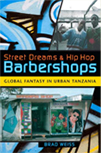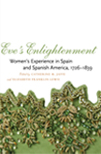The Magazine publishes a selection of general-interest books by alumni authors. For additional alumni books, see “In Their Own Words” at magazine.uchicago.edu/books.
 Street Dreams and Hip Hop Barbershops: Global Fantasy in Urban Tanzania, by Brad Weiss, AM’86, PhD’92, Indiana University Press, 2009. By examining barbershops with names like Brooklyn Barber House and Boyz II Men, Weiss observes the influence of hip-hop culture on urban Tanzanian youth. In these East African shops, he argues, young men grapple with a struggling local economy and work to understand their place in the world.
Street Dreams and Hip Hop Barbershops: Global Fantasy in Urban Tanzania, by Brad Weiss, AM’86, PhD’92, Indiana University Press, 2009. By examining barbershops with names like Brooklyn Barber House and Boyz II Men, Weiss observes the influence of hip-hop culture on urban Tanzanian youth. In these East African shops, he argues, young men grapple with a struggling local economy and work to understand their place in the world.
Art Museums PLUS, by Traute M. Marshall, AM’68, PhD’74, University Press of New England, 2009. Marshall’s guide to New England museums, large and small, offers both logistical information and a thorough introduction for each venue. The entries situate the museums within their particular cultural and historical context, outline their relationships with the surrounding areas, and explore the architecture, history, and collections that shape their identities.
Czech Plays: Seven New Works, edited by Marcy Arlin, AB’72; Gwynn MacDonald; and Daniel Gerould, AB’46, AM’49, PhD’59; Martin E. Segal Theatre Center Publications, 2009. This anthology gathers seven plays written after the 1989 Velvet Revolution. The collection is diverse in style and content, confronting the social realities that come with democracy; the cultural effects of globalization; sexual and ethnic identity; political corruption; and religious taboos.
Divine Margins, by Peter Cooley, AM’64, Carnegie Mellon University Press, 2009. Cooley’s new poetry collection concerns the point of transition from darkness to light. Through his parents’ and sister’s deaths, he draws on iconic figures and myths from Christianity and shapes his mourning into a poetic celebration: a collection of aubades, pieces written for the early-morning dawn.
 Eve’s Enlightenment: Women’s Experience in Spain and Spanish America, 1726–1839, edited by Catherine M. Jaffe, AM’81, PhD’86, and Elizabeth Franklin Lewis, Louisiana State University Press, 2009. History, art-history, literature, and psychology scholars examine how Enlightenment philosophies and developing legal and social norms affected women’s everyday experiences in Spain and Spanish America. Looking at women’s portrayal in art and literature, the contributors argue that, despite gaps between Enlightenment ideals such as gender equality and women’s actual experiences, they influenced the Spanish-speaking world’s social and cultural shift toward modernity.
Eve’s Enlightenment: Women’s Experience in Spain and Spanish America, 1726–1839, edited by Catherine M. Jaffe, AM’81, PhD’86, and Elizabeth Franklin Lewis, Louisiana State University Press, 2009. History, art-history, literature, and psychology scholars examine how Enlightenment philosophies and developing legal and social norms affected women’s everyday experiences in Spain and Spanish America. Looking at women’s portrayal in art and literature, the contributors argue that, despite gaps between Enlightenment ideals such as gender equality and women’s actual experiences, they influenced the Spanish-speaking world’s social and cultural shift toward modernity.
The Private Equity Edge: How Private Equity Players and the World’s Top Companies Build Value and Wealth, by Arthur B. Laffer; William J. Hass, MBA’71; and Shepherd G. Pryor IV, MBA’74; McGraw-Hill, 2009. In an unpredictable global economy, there is undeniable risk involved in most business decisions. But for the authors, this volatile time also offers opportunities to build value and reduce risk. They draw on examples of private-equity firms such as Blackstone and Carlyle to construct a new strategy for success.
 The Human Footprint: A Global Environmental History, by Anthony N. Penna, AM’61, Wiley-Blackwell, 2009. Penna weaves together Earth’s natural and human history, drawing on recent research in geology, climatology, evolutionary biology, anthropology, and other disciplines. From this analysis he forms a single narrative that expands upon human evolution, industrialization, and population growth.
The Human Footprint: A Global Environmental History, by Anthony N. Penna, AM’61, Wiley-Blackwell, 2009. Penna weaves together Earth’s natural and human history, drawing on recent research in geology, climatology, evolutionary biology, anthropology, and other disciplines. From this analysis he forms a single narrative that expands upon human evolution, industrialization, and population growth.
Across Generations: Immigrant Families in America, edited by Nancy Foner, AM’68, PhD’71, New York University Press, 2009. The common view of assimilated children battling old-country parents oversimplifies intergenerational tensions in immigrant families, the contributors argue. Examining relationships within families and across immigrant groups and shifting sets of cultural expectations, the book offers not only a portrait of life in these immigrant families but also an understanding of how such diversity makes for a richer nation.
The Corporeal Imagination: Signifying the Holy in Late Ancient Christianity, by Patricia Cox Miller, AM’72, PhD’79, University of Pennsylvania Press, 2009. Late-ancient Christianity scholarship traditionally has highlighted the religion’s drift toward the abstract and the transcendent. Yet Miller, using ancient texts, argues that between the fourth and seventh centuries the perspective shifted to one of the material world as rich with holy power, reorienting humanity’s relationship to the divine.
